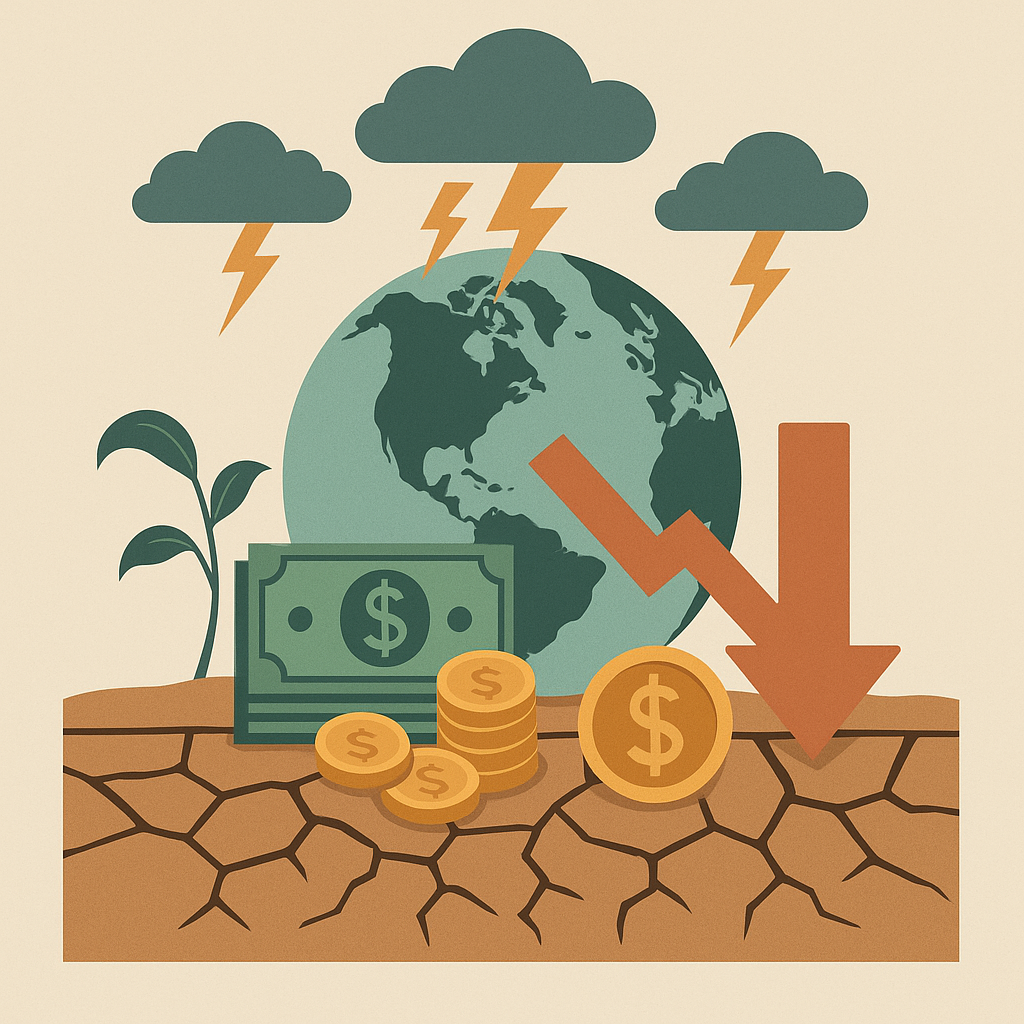🔍 Introduction
The Economic Cost of Climate Change: Are We Accounting for the Future? The conversation around climate change has largely centered on melting glaciers, rising sea levels, and erratic weather. However, one of the most pressing yet under-discussed aspects is the economic cost of climate change. From damaged infrastructure to declining productivity and rising healthcare costs, the financial implications are staggering. Yet, are we truly factoring these future costs into today’s economic decisions?
Table of Contents
💸 The Visible and Hidden Costs of Climate Change
Climate change is already costing the global economy hundreds of billions of dollars annually. These costs arise from both sudden events like hurricanes and floods, and gradual changes such as droughts, sea-level rise, and declining agricultural productivity.
🌀 Natural Disasters and Recovery
Extreme weather events are becoming more frequent and severe. For instance, Hurricane Harvey (2017) caused $125 billion in damages in the U.S. alone. Similar events globally are increasing government spending on disaster relief and insurance payouts.
🌾 Impact on Agriculture and Food Security
Crop yields are expected to decline by 5-30% by 2050 due to increased temperatures, water scarcity, and pest outbreaks. This not only affects farmers but also drives up food prices, destabilizes economies, and exacerbates poverty and hunger.
According to a study by the Global Commission on Adaptation, climate change could push over 100 million people into poverty by 2030 if no urgent action is taken. Source
🏥 Public Health and Economic Burden
Rising temperatures have direct and indirect health consequences—heatwaves, spread of vector-borne diseases, respiratory illnesses, and mental stress. These increase healthcare costs significantly. For instance, the World Health Organization (WHO) predicts that climate change will cause 250,000 additional deaths per year between 2030 and 2050 due to health-related issues.
🧮 Are We Accounting for These Costs?
Unfortunately, many countries and businesses still operate on short-term economic models, often ignoring the long-term financial consequences of environmental degradation.
🏛️ GDP Is Not Enough
Gross Domestic Product (GDP) does not account for environmental degradation or future costs. For example, rebuilding after a flood increases GDP, even though the disaster reflects a net economic loss. As economist Joseph Stiglitz puts it, “GDP measures everything, except that which makes life worthwhile.”
💡 Need for Climate-Adjusted Economic Models
There’s a growing push for models like the Inclusive Wealth Index and Green GDP, which consider ecological and human capital. These can give a more realistic picture of a country’s long-term economic sustainability.
🧾 Corporate Accountability and ESG Reporting
Businesses are slowly adopting Environmental, Social, and Governance (ESG) frameworks, but only a fraction report comprehensively on climate-related financial risks. Mandatory disclosure frameworks like TCFD (Task Force on Climate-related Financial Disclosures) aim to change that. Learn more here.
🌐 Global Economic Impact: A Deep Dive
🔥 Developing Countries Bear the Brunt
Ironically, the countries least responsible for emissions are the ones suffering most. Nations in sub-Saharan Africa, Southeast Asia, and small island states face devastating effects with limited resources to recover.
- For example, Bangladesh could lose 11% of its GDP by 2050 due to sea-level rise and crop loss, according to the Asian Development Bank.
💼 Labor Productivity and Migration
In hotter climates, outdoor labor becomes dangerous or less efficient. According to the International Labour Organization (ILO), by 2030, the equivalent of 80 million full-time jobs could be lost due to heat stress alone. Moreover, climate-driven migration will place economic strain on both origin and destination countries.
📈 The Price of Inaction vs. The Cost of Prevention
A common misconception is that fighting climate change is too expensive. However, inaction is far costlier in the long run.
📊 Stern Review on the Economics of Climate Change
Economist Nicholas Stern famously concluded that acting now would cost about 1% of global GDP, while inaction could cost up to 20% or more. His landmark report reshaped the way economists and policymakers perceive climate risk.
🧱 Investing in Resilience Pays Off
Every $1 spent on climate adaptation (like early warning systems, green infrastructure, or water conservation) can yield $4 in benefits, says the Global Commission on Adaptation.
A detailed breakdown of these returns can be found in this GCA report.
🔧 What Needs to Change?
To truly address the economic cost of climate change, we need systemic reforms across policy, business, and individual behavior.
📜 Policy-Level Actions
- Carbon Pricing: Make polluters pay for emissions through carbon taxes or cap-and-trade systems.
- Green Subsidies: Shift funding from fossil fuels to renewable energy and sustainable agriculture.
- Mandatory Risk Disclosure: Enforce climate-risk reporting across public and private sectors.
🏢 Corporate and Financial Sector Role
- Climate Stress Testing for banks and investment portfolios.
- Internal Carbon Pricing to steer decisions towards low-carbon options.
- Transition Funds to support industries and workers in moving to greener practices.
🧑🤝🧑 Individual and Consumer Behavior
- Choosing sustainable products
- Reducing energy and water consumption
- Supporting businesses with transparent climate goals
🧠 A Mindset Shift: From Expense to Investment
We must stop viewing climate action as a burden. It is a strategic investment into the future of our economies, societies, and planet. Clean energy, green jobs, climate-resilient infrastructure—these aren’t luxuries, but necessities that can drive inclusive growth.
✅ Conclusion
Climate change is not just an environmental issue—it’s an economic crisis unfolding in real-time. From lost jobs and rising healthcare costs to food insecurity and displaced populations, the financial toll is vast. Unless we rethink our metrics, policies, and priorities, we’ll continue to pay a higher price—both literally and figuratively.
The future isn’t something to budget for later. It’s a cost we’re already incurring. The question is: will we invest wisely now or pay dearly later?
Find more Finance content at:
https://allinsightlab.com/category/finance/

